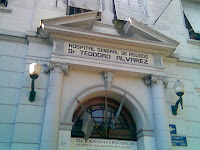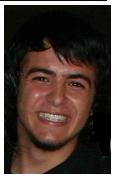- Templo del Sagrado Corazón It was built in 1760 This building played a very important role during indepence battles and civil wars. It was here where Belgrano General took up the North Army control again, taking Rondeau General`s place. The church was rebuilt in 1827 after 1826` earthquake. It witnessed the execution of Bernabé Aráoz, Tucuman´first governor, and Lola Mora, the most important tucuman sculptress, was baptized inside of it. It continues with viceregal archiotectural forms, though it has the appearance of one postcolonial building. It keeps San Joaquin`s Image carved in wood which was brought from Alto Peru.
- Pozo del Pescado (Fish well) It is a miraculous origin fountain to the believers. It reminds Saint Francis crossing through the town. It is said that Saint Francis made water appear from it in order to fight its followers thirst. The misioneer walked all the way around the North of Argentina converting all the natives into believers with his violin. There is a Party that commemorates this the first Sunday after Eastern.
San Pedro de Colalao
In this Turistic Village you can find the best balance between nature and the man. It counts with the appropriate infrastructure and services for the visitors.
San Pedro de Colalao is one of the first Tucuman turistic centres. It is located 93 kilometers away from San Miguel de Tucuman. After taking rout 9 you have to take rout 311 to get into this beautiful small town.
By the end of the seventeenth Century Captain Pedro de Avila y Zárate and the high priest Luis Marañon founded, with forty seven indians, the "Encomienda de San Pedro de Colalao". This was the origin of this village surrounded by impressive farms. In 1858 the community donated land to the Church and with the land parcels sale, a new population nucleus started to get shaped. The town Commune was created in 1901 and in 1902  San Pedro Church was founded. It was there where the jesuits taught the locals all the farmwork and handmaking skills. Inside the church there is a 300 years old bell, which was first lost by the monks on one stormy day and alter found by them in the river-bed.
San Pedro Church was founded. It was there where the jesuits taught the locals all the farmwork and handmaking skills. Inside the church there is a 300 years old bell, which was first lost by the monks on one stormy day and alter found by them in the river-bed.
You can find archeological sites that belonged to the Ayampitin, Ampajango and Candelaria culture in all their phases. In San Pedro´s Museum you cand find rocks carved by these tribes.
The village is surrounded by two rivers: the Tipas and The Tacanas. Is is located at 1087 meters over the sea. It has a dry climate with minimum temperaturas between 18 and 25 degrees Celsius and maximum temperaturas around 38 degrees. It is an Ideal place for campings, cavalcades, trekking and tourism.
Different festivities such as the Fiesta del Quesillo and the Fiesta de la Humita in January, the Fiesta del Caballo Peruano (peruvian horse party) in March, the Nuts festival during Eastern, the Fiesta del Locro in July, and others, take place the year round.
- San Pedro´s Church. Its construction was in charge of Medici brothers, natives of Modena, and began in 1895. Inside the church, there is a linen that represents the Immaculate Concepcion, work of the Italian Gaspar Spadafora. Between most ancient pieces (300 years) and the ones with major religious value there is the image of the Holy Patron, sculpture carved in soft (smooth) wood of popular tone. The Bell History: It is said by tradition that Jesuits brought it in the middle of the 17th century. Of golden, iron and copper alloy, after being missed many years ago, it was found in 1980 in the river-bed. The 87 kilos bell shows itself in the porch of the Church.
- The Lourdes
 Grotto: This religious site is located in the bottom of the hill at the entry of this village. It isa replica of “Lourdes Grotto” in France in which walls there is an incrusted stone brought from the original Grotto. The Virgin of Lourdes is considered to be the second mistress of the village and enjoys great devotion among San Pedro´s community. In February thousands of faithful people congregate to attend the play of the Miracle of the Virgin of Lourdes, represented by professional actors and local collaborators.
Grotto: This religious site is located in the bottom of the hill at the entry of this village. It isa replica of “Lourdes Grotto” in France in which walls there is an incrusted stone brought from the original Grotto. The Virgin of Lourdes is considered to be the second mistress of the village and enjoys great devotion among San Pedro´s community. In February thousands of faithful people congregate to attend the play of the Miracle of the Virgin of Lourdes, represented by professional actors and local collaborators.
- Dr. Carlos Pellegrini Nature Reserve: It is located 5 kilometers away from the village square. In a two hours and a half tour you can appreciate more than 150 exotic species (Toucans, lions, Bengal tigers, Flemings, etc) and autochthonous (Foxes, eagles,
 pumas, tapirs, etc.). An echological circuit goes around 1700 meters going through Tipas y La Angostura rivers. There you appreciate Las Yungas typical flora. The site has a quincho (place where people gather in order to have lunch or dinner) for more than 120 people. Educational excursions and tourist visits are frequent. Contact Information: Las Tipas - CP:4124 - tel:(0381) - 4245375 / (0381) - 4201867
pumas, tapirs, etc.). An echological circuit goes around 1700 meters going through Tipas y La Angostura rivers. There you appreciate Las Yungas typical flora. The site has a quincho (place where people gather in order to have lunch or dinner) for more than 120 people. Educational excursions and tourist visits are frequent. Contact Information: Las Tipas - CP:4124 - tel:(0381) - 4245375 / (0381) - 4201867
- Piedra Pintada (Painted Rock): This rock of enormous size is one of the most valuable archaeological relics that San Pedro of Colalao preserves. After a one hour
 and a half trek you get access into a huge plateau surrounded by rivers and lots of vegetation in which center you can find the Painted Rock, as it popularly known.This rock has 3 mts. of length, 2,30 mts. of width and 1,60 mts. of height, and is buried approximately 2 mts below the current level of the area. It was discovered in 1877 by profesor Inocencio Liberan. Its size is impressive as well as the enigmatics figures carved in each of its sides. The meaning of those figures is not known yet but it is believed that they are related with worships to fertility and harvest. There are as many as 45 figures.
and a half trek you get access into a huge plateau surrounded by rivers and lots of vegetation in which center you can find the Painted Rock, as it popularly known.This rock has 3 mts. of length, 2,30 mts. of width and 1,60 mts. of height, and is buried approximately 2 mts below the current level of the area. It was discovered in 1877 by profesor Inocencio Liberan. Its size is impressive as well as the enigmatics figures carved in each of its sides. The meaning of those figures is not known yet but it is believed that they are related with worships to fertility and harvest. There are as many as 45 figures.
- Tiu Cañada:7 kilometers southwest from San Pedro you can find this place that has a big rock in the middle and many rocks around it, forming a rock sun Calendar. Tiu Cañada could have been an aboriginal village and the calendar might have been used to determine when to irrigate and when to work the ground.
HUALINCHAY
18 km west from San Pedro´s villa, you can find this beautiful and picturesque hamlet surrounded by mountains that turn it into a visual attraction of singular importance and interest. It is located 1700 meters over the sea and it counts with one camping with mountain water pools. From this small town you can walk or ride a horse in order to get into Colalao del Valle. It is recommended to be accompanied by a guide.
In diaguita voice it means: talented, crafty or lullaby of dove. This village is located to the side of RN 40 which crosses through its center.
It is a calm summery village covered with aged groves, which acquired diverse designs and formed beautiful galleries. These attractions as well as the irrigation chanels, the vineyards, fruit-bearing and traditional pircas, turn Colalao del Valle into a place worth knowing and enjoying.
Its nearness with other towns of Tucumán, Salta and Catamarca makes Colalao one important center of one beautiful and singular tourist circuit known as Calchaquíes Valleys.
The region is rich in archaeological deposits that indigenous civilizations that inhabited the site left. These relics remain still today and show us the living signs of their historical presence.
The villa has a singular beauty, the warmth and simplicity of the community and the tranquility and peace that surround the environment make this place the perfect summery escape. It is located 196 kilometres away from San Miguel de Tucumán. You only have to take National rout 40, which is totally paved. The Sun shines all year round and good weather is guaranteed by nature. These allows to enjoy the stay without any limitations.
You can enjoy activities such as trekking, rides in bicycles, cavalcades, walks, etc.
In January a festivity that worships Los Antigales, the village ancestors, takes place. There are craftsmen’s exhibitions, sites with regional food and drinks, and Gaucho’s parades where they show their skills. During July the Ponchi´s Festivity takes place. The Ponchi is a beverage made of milk, brandy, sugar, cinnamon and whipped eggs.
El Pichao
It Is located around 8 km away from Colalao del Valle. Here you can find the Condor Huasi Culture Ruins. This is a small village with aged customs. In February the Fiesta de los Dulces Artesanales (hand made sweets festivity) takes place. Theses Sweets are well known because of their quality.
Heading south, taking rout 311 and after taking rout 312 you arrive to RN 9. Along all this road you will be able to appreciate beautiful valleys full of nature and admirable views. You will go through little towns such as Gonzalo and Choromoro. You will also be able to get a look at local farmsWhere To Sleep
San Pedro de Colalao
§ Huayco Lodging House- 9 de julio just across Leocadio Paz Square - CP:4124 – TEL: (03862) - 481040 / 481219
§ Intihuana Cabins: Las Calandrias Street without number - Bº Las Rosas - Villa Gloria - San Pedro de Colalao - CP:4187 – TEL: (0381) - 4345369 / 4230600 – cabanaintihuana@hotmail.com
§ Santa Rita Lodgings: centre street – Villa Rita – CP:4124 – TEL: (0381) – 4390703/ 154154451 – www.santaritahospedaje.com.ar
§ La Casona Guests House – 25 de Mayo and San Martin – TEL: (0381) – 155881303
§ El Lapacho Hotel – RP 311 – km 24 – TEL: (03862) – 481069 – hosteriaellapacho@hotmail.com
Colalao del Valle:
§ Colalao del Valle Lodging House: 9 de Julio s/nº - CP:4141 – TEL: (0381) –155909475
§ El Alamo Coplero Camping – RN 40 – KM1017 – CP:4141 – TEL: (0381) – 4221226 / 154160420 – www.iespanaelalamocoplero.com
Where to Eat
San Pedro del Colalao:
§ El Lapacho Hotel
§ Huayco Bar and Pizzas – Las Heras 3rd block – CP:4124 – TEL: (03862) – 481040
§ La Finca – Campside Club – RP 311 – CP: 4124
§ Las Tinajas Grill – Tucumán 4th block – CP: 4124 – TEL: (03862) - 481042




